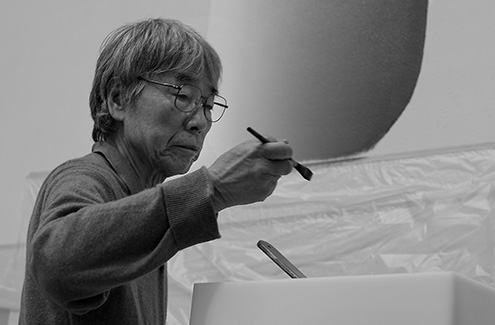Lee Ufan

Lee Ufan was born in Haman, South Gyeongsang Province in 1936 and spent his childhood in Busan. He entered the College of Fine Arts at Seoul National University during the Korean War, but soon after, he went to Japan, where he graduated from the Department of Philosophy at Nihon University. Currently, he is active in the international arena, dividing his time between Korea, Japan, and France.
Having spearheaded the avant-garde art movement of “Mono-ha” (“School of Things” in Japanese) in the late 1960s, Lee Ufan laid a theoretical foundation for the movement intended to present artistic arrangements of raw, untreated natural and industrial materials. The movement remained formally and conceptually contemporary in Japan up until the 1970s, and significantly influenced the Korean art scene.
He was awarded numerous domestic and international art prizes, including the UNESCO Prize and the Praemium Imperiale international art prize in Japan. He was also awarded the Geumgwan (Gold Crown) Order of Cultural Merit by the Korean government in 2013 for his contributions to the development of culture and art in Korea. He has had numerous solo and group exhibitions in the world’s major art museums, including the Royal Museums of Fine Arts of Belgium, the Centre Pompidou in Paris, and Alte Nationalgalerie (Old National Gallery) in Berlin. Invitational exhibitions of his work have also been held at the Guggenheim Museum in New York in 2011 and the Palace of Versailles in France in 2014.
Chronology
1930’s1970’s
- 1936
- Born in Haman, South Gyeongsang Province (Korea)
- 1956
- Entered College of Fine Arts at Seoul National University, moved to Japan 3 months later
- 1961
- Graduated from Dept. of Philosophy at Nihon University, Tokyo
- 1967
- Solo exhibition, Sato Gallery, Tokyo
- 1968
- “Contemporary Art of Korea” exhibit at Tokyo National Museum of Modern Art Came to know Japanese sculptor Nobuo Sekine in summer of 1968, then started the Mono-ha movement through artistic production and criticism.
- 1969
- Awarded prizes at 10th Sao Paulo Biennale, Tokyo International Youth Artists Art Exhibition, and 9th Contemporary Japanese Art Exhibition. His critical essay “From Object to Being” received an honorable mention.
- 1971
- 7th Paris Youth Biennale. First trip to Europe and the U.S. for 3 months. Published a book of criticism titled The Search for Encounter (Tokyo, Tabata)
- 1973
- Became an instructor at Tama Art University, held professorship through 2007
- 1977
- Kassel Documenta 6 and 3rd Contemporary Japanese Art Exhibition Received art prize from Tokyo National Museum of Modern Art Part of group exhibition titled “Z.B. Skulptur” at the Städel in Frankfurt (with Joseph Beuys, Richard Serra, and Ulrich Rückriem, among others)
